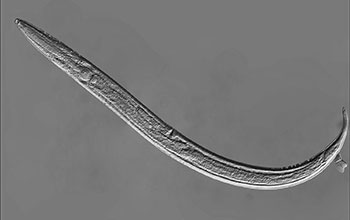Multimedia Gallery
Light micrograph of adult Antarctic nematode worm
A light micrograph of an adult Antarctic nematode worm Plectus murrayi in its hydrated, ecologically active state. The worm was found in soil samples collected at the McMurdo Dry Valleys Long Term Ecological Research (LTER) site.
More about this image
When water inside a living thing freezes, ice crystals pierce cell membranes and kill them (which causes frostbite). But the nematode creates a protein that probably prevents the ice from forming sharp crystals or coats them so they don't puncture anything. Identifying the genes the worm uses to kick in its antifreeze system could have potential in future research such as engineering frost-resistant crops.
Following their study, the LTER researchers published a report in which they described a nematode worm they found that could withstand its cold Antarctic climate by creating a sort of antifreeze. The researchers also reported that when its environment runs dry, the nematode dries itself out and goes into suspended animation until liquid water brings it back to life. Byron Adams, an associate professor at Brigham Young University (BYU), says this unique genetic response to its environment indicates the nematode will likely flourish as Antarctica gets wetter due to climate change, while other nematode species diminish.
The samples collected and data generated for this research were done under the auspices of the McMurdo Dry Valleys LTER (under NSF grant OPP 9810219) and administered under NSF's Office of Polar Programs. Adhikari received funding from NSF.
To read more about this study, see the BYU news release BYU study: How an Antarctic worm makes antifreeze and what that has to do with climate change. (Date of Image: 2009)
Credit: Bishwo Adhikari, Department of Biology, Brigham Young University
Images and other media in the National Science Foundation Multimedia Gallery are available for use in print and electronic material by NSF employees, members of the media, university staff, teachers and the general public. All media in the gallery are intended for personal, educational and nonprofit/non-commercial use only.
Images credited to the National Science Foundation, a federal agency, are in the public domain. The images were created by employees of the United States Government as part of their official duties or prepared by contractors as "works for hire" for NSF. You may freely use NSF-credited images and, at your discretion, credit NSF with a "Courtesy: National Science Foundation" notation.
Additional information about general usage can be found in Conditions.
Also Available:
Download the high-resolution JPG version of the image. (148 KB)
Use your mouse to right-click (Mac users may need to Ctrl-click) the link above and choose the option that will save the file or target to your computer.



